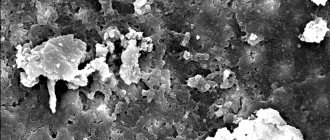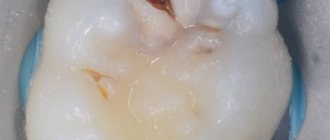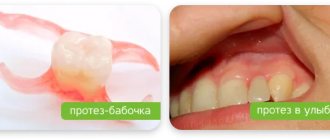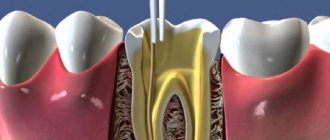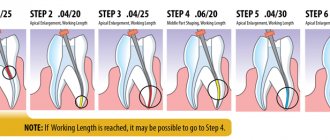Sometimes situations arise when it is necessary to refill a dental canal. The reasons for such cases may be different. For example, poor-quality root canal filling, incorrect identification of the source of infection during initial treatment. In addition, the structure of the patient’s tooth or a violation of the tightness of the installed filling also affects the result of tooth treatment. We will tell you about the reasons for the need to refill a tooth and the rules for its implementation to obtain a reliable result.
Features of the procedure for re-treatment of a dental canal
Refilling the canal of a previously treated tooth is a special case in the practice of dentists. Before doing this, it is necessary to remove the old filling, clearing the entire dental canal of the filling material. During such work, the flexible rod may break. This will somewhat complicate the dental treatment process.
Typically, this problem occurs with a very dense filling that is closely adhered to the walls of the canal of the tooth being treated.
Difficulty also arises if it is necessary to refill curved dental canals. When cleaning such channels, you can damage their walls or even break the instrument. Such situations require increased attention from the specialist to ensure high-quality completion of the canal filling. Specialists are required to inform the patient about possible difficulties during treatment before the procedure.
What hurts if there is no nerve?
All of the above cases can be attributed to partial filling. What if all the root canals are closed with fillings, and the nerves from them have been previously removed? Where does the pain come from if the tooth is “not alive”?
Many experts believe that there should be no pain in this case. But, since it still occurs, and in a significant number of patients, the question of the origin of pain in a tooth without nerves remains open and hotly debated.
The tooth may hurt even after the nerve is removed
In what cases can you not worry that after filling the canals under a temporary or permanent filling, pain continues?
Important! Short-term pain in a tooth where there is no nerve, even if all the work on removing nerves, cleaning and filling canals was carried out according to the protocol and without errors, is a normal phenomenon.
Table. Nature of pain after root canal filling
| How it manifests itself | Description | Cause | What to do |
| Pain during biting | After the installation of a filling, usually temporary, is completed, pain occurs several hours or days later. There are painful symptoms when biting (from pressure). | If the level of occlusion is not too high, the reason is the reaction of the peri-root tissues to the extraction of the nerve. The root canal is expanded and filling material is introduced into it. The body reacts to a stimulus. | In this case, you can do nothing. The pain lasts from 5 days to 3 weeks. Pain dynamics should be positive (gradually subsiding, until disappearance). |
| Aching pain under the filling | After the anesthesia wears off, aching pain remains under the filling. | This is also due to the body’s reaction to the removal of the nerve. The disturbed canal walls “whine.” | The pain can last from two hours to a day. If it continues longer, you should consult a doctor. |
| Jerking pain inside the canal | This type of pain is rare. It’s as if something is tugging in the tooth; the sensation may resemble the beginning of inflammation of the pulp. | It occurs exclusively as an individual reaction of the body to the expansion of the canal or to the filling material itself (its structural component). | The tooth can also “tug” from hours to days. In a maximum of a day everything should go away. |
Why undergo a dental canal refilling procedure?
There are several reasons why you need to re-treat a dental canal:
- persistence or resumption of pain after filling;
- X-ray shows the presence of inflammation;
- incomplete closure of dental canals.
In addition, complications may result from errors or inaccuracies that arose during treatment. For example, when preparing the canal for treatment, an infection was introduced, access to the base of the canal is impossible, or there are pathological holes in the walls of the tooth or its bottom. In addition, no one is immune from the mistakes of the doctor performing root canal treatment.
When treating a dental canal before filling, the following problems most often occur:
- Dentim gets into the sawmill,
- the middle part of the canal is greatly expanded,
- tool failure,
- the integrity of the root walls is compromised.
When filling a canal, the main problems arise if it is not completely filled, the filling material extends beyond the hole, or there is a longitudinal fracture at the root of the tooth. Medical errors are also possible at this stage - the doctor may incorrectly estimate the length of the canal or not completely clean it. This may contribute to the development of inflammation.
Why does it hurt?
The first thing you need to understand is the impact on the enamel coating of a tooth or its underlying tissue (dentin) with a drill drill or any instrument penetrating into the tissue, and even more so, cleaning the canals is a real surgical intervention. In the process of working with a drill, the dental nerves are usually affected by an anesthetic injection; when it stops its effect, the pain becomes obvious and can be felt quite strongly for a short time. The surgical wound heals, the body recovers, this should take a certain period of time, such pain after filling the canal is considered normal.
Toothache after root canal filling is acceptable
How to understand at what point a deviation from the norm occurs, and when you need to seek help or take independent auxiliary measures?
By the way. There are certain criteria by which they calculate whether it is normal or deviation. With a natural pain reaction, it is enough to wait for some time. If something goes wrong and the pain continues and even intensifies, the algorithm of actions will be different.
Criteria for determining pain norm.
- The nature and level (depth) of the treatment performed.
- The presence of complications after treatment, or non-standard reactions of the patient’s body.
- Duration of pain.
- Dynamics of pain.
- Nature of pain.
Pain may indicate complications after surgery
What causes pain? They are divided into objective and subjective. The second category includes typical medical errors, errors in diagnosis, incorrect treatment or insufficiently high technology of the clinic’s equipment.
Caries or pulpitis
Deep caries
Unfortunately, very often, even in expensive dental clinics, it happens that the doctor incorrectly identifies the patient’s problem. For example, deep caries is confused with chronic pulpitis. Yes, they are similar and have almost identical manifestation. But if caries is suspected, especially when the doctor, with the best of intentions, seeks to avoid root canal treatment, this mistake can cost the patient not only a long period of pain, but also tooth loss. If you apply a filling for any form of pulpitis or periodonitis without cleaning and filling the canal, the tooth will hurt deep down until the inflammatory process reaches its culmination stage and tooth extraction is required. Thus, paradoxically, the first cause of pain may be that the doctor did not fill the canals.
Pulpitis
Burn pain
It would seem like getting a burn in the dentist's office? Overheating and tooth burns are a problem mainly in small budget clinics that have outdated equipment that does not provide for the use of water-air cooling.
During treatment, tooth enamel may burn
If the fragment of tooth tissue processed by the drill is not cooled enough, it overheats and burns the pulp tissue. As a result, a necrotic area is formed, which in the future will cause pain under the filling. The killed tissue will decompose, giving inflammation of the pulp, periodontitis, pulpitis and further, as in the previous paragraph.
- Tooth hurts under temporary filling
Overbite
Few patients take this source of pain seriously. After filling the canal, a closing filling is applied to the dentin. At the moment of biting, a tooth from the opposite row presses on the filling. If the bite level is normal, the pressure is distributed over the entire dentition. But if it is too high, the entire jaw puts pressure on the filled tooth.
Overbite filling
By the way. Patients, and even doctors, tend to believe that a protruding filling will “wear in” over time. This is a big misconception; modern filling materials are durable. It may take years to “grind in.” And at this time, each bite will not only cause pain in the tooth, but also injure the peri-root tissue. As a result, traumatic periodontitis will develop.
The specialist must carefully monitor the height of the bite, since the patient himself, by feeling, cannot accurately determine whether it is too high. The treatment takes place under anesthesia. There is numbness in the mouth. Feelings are blurry and unclear.
To check the bite filling, use special paper, similar to a copy.
Important! If, after filling, the tooth hurts when pressed, you need to go to the dentist and grind the filling down to a comfortable level.
Shrinkage of the filling
Another reason that most patients are not even aware of is polymerization stress. Happens when installing light-curing composites (so-called light fillings). They subsequently shrink and begin to hurt. This happens because a special lamp is used to harden the filling material. After its exposure, the composite material decreases in volume. Of course, this is not at all the shrinkage that occurs if you wash woolen fabric in boiling water, but even a slight decrease in the volume of the filling causes stress on the surrounding tooth walls. If the filling is multi-layered, the tension is greater, the stress is greater. A light filling may hurt for several weeks, or may cause discomfort for a long time.
Close-up view of light filling
How does the process of refilling dental canals take place?
The current level of development of medicine in the field of dentistry is quite high. But dentists make mistakes, which is why filling dental canals again is quite common. At this point in time, doctors use several methods for performing this procedure.
Mechanical methods involve the use of a special instrument - an endodontic motor and an apex locator. In this case, antiseptic agents are added to the filling material. To prevent the development of inflammation, the doctor must very carefully and completely fill the dental canal with filling material.
Medicinal methods involve the use of products with organic solvents. They are able to soften and destroy the filling in a few minutes.
The cement filling can be removed from the canal using ultrasound and an endo-nozzle. This canal cleaning is usually carried out in one procedure.
Preparation stages:
- Treatment of carious cavities is a necessary procedure in order to avoid infection getting to the root. This also allows access to estuaries.
- Pulp removal - this procedure can be carried out using several methods, most often it requires two visits. At the first stage, the pulp is necrosis; at the second, it is directly removed.
- Determining the length is a particularly important stage, since each tooth in an individual patient has its own individual characteristics, both length and relief.
- Processing with mechanical instruments - at this stage, the channels are passed through to expand them. This is the main step towards quality filling. A canal that is not completed to its full length can never be adequately healed.
- The final stage is filling with gutta-percha.
It is important to take into account that the last stage directly depends on the previous ones, and if all standards are not followed, it cannot be carried out.
Channel length measurement
Root canals must be filled exclusively to the apex of the root. What happens if you ignore this point?
The canal will not be completely sealed; unfavorable microflora will begin to multiply in it. This will further lead to inflammation, complex periodontitis and then the tooth will need to be removed.
It will be over-sealed - in this case, there may be various complications. If it is a tooth on the upper jaw, gutta-percha can enter the nasal sinus - this will be odontogenic sinusitis. Another complication may arise due to damage to the nerves - neuralgia, severe pain, and subsequently inflammation.
Therefore, through trial and error, the dentist is obliged to take measurements from beginning to end.
Mechanical restoration
The next stage is mechanical processing of the cavity. The main task is to make the tooth suitable for further filling. To do this, it is necessary to remove all narrowings and expand the channel as much as possible. This is done in two ways.
In interaction with the endodontic handpiece - the so-called Pro-files. These devices rotate in the cavity of the root canal, thereby removing all unwanted tissue and expanding it.
With the help of a hand instrument, the dentist independently rotates such instruments in the tooth.
Gutta-percha filling
The final stage is filling with gutta-percha.
There are several methods for this:
- Thermofil system - filling is carried out with heated material, and already in the canal it begins to harden. This is a highly effective method, but it also has disadvantages. This is a difficult procedure to carry out, expensive and requires high professionalism of the doctor.
- Single paste method - this method involves filling the canal with a plastic material. To date, a more dangerous filling method is not yet known, since complications occur in almost every case.
- Lateral condensation method - this technique is the safest and allows you to get good results. In this case, the canals are filled very tightly with gutta-percha, thereby guaranteeing that the entire canal is filled.
In case of pulpitis and periodontitis, the quality of treatment is assessed not only by the patient’s complaints. In addition to pain, a feeling of fullness and discomfort, a control image can tell a lot.
A mandatory conclusion of dental filling is radiographic control. It is carried out both before the procedure, during the treatment process, and after filling. In the picture you can see the quality of the work performed, and if necessary, re-sealing occurs.
Modern technologies in the field of tooth refilling
Dental treatment under a microscope is one of the newest services that has appeared in dentistry. High-tech equipment allows specialists to fill the dental canal with better quality, more accuracy and efficiency. Thanks to the use of such a device, the likelihood of causing harm to healthy tissue is close to zero. In addition, the treatment is carried out very delicately. Microscope glasses allow you to view the tooth at multiple zooms. This will allow you to see all the affected areas that may simply not be visible during normal examination.
A microscope allows dentists to perform root canal treatment faster and safer for the patient.
The nerve was removed, but the canal was not sealed
Such situation. On the X-ray of my teeth, they saw that in my six, in which the nerves were ripped out, only one canal was sealed. My employee’s nerve was removed and the canal was also not sealed - the filling was only placed on top. The fillings are not temporary, but permanent. It turned out to be completely random - during a check when another tooth (mine) was hurting. And the employee was sick after that, the hollow one.
Is there any reasonable explanation for the fact that the nerve is removed, but the canal is not filled and the filling is left only on top, or is this real negligence?
There are several options. Possibly negligence. But if one channel is sealed, then most likely there is another option. I haven't completed channels 5 and 6 yet. This turned out to be the case in the USA. The previous dentist in the USA turned a blind eye to this. We moved and took the new one to a specialist to do a refilling. Well. I did it in a cool place, with a cool specialist, a professor. I paid more than 3 tons of dollars for two teeth (5 and 6 on the lower left). And still, the channels have not been completed completely. He told me that you have very narrow and winding canals, plus 4 roots. The Russians used a different technology to fill the filling, but it surprisingly didn’t work too badly. Don't touch your teeth anymore. If inflammation occurs, you will have one way out - open the gum, bite off the tip of the root and fill it at the other end.
Removing the seal under the anchor pin
Obturation of the tooth root canal is done in parallel using anchor pins. If the filling in the lower part of the root is placed correctly and hermetically, then it is left to install the pin structure. This procedure is carried out over two trips to the dental office.
On the first day, the doctor treats the dental canal mechanically, softens the filling with medications and cleans the passage with an endo-instrument. The doctor then soaks a cotton swab in the medicine and inserts it into the canal. The patient takes the medicine for a couple of days and then makes another visit to the doctor, during which the cotton swab is removed and the canal is refilled.
How to understand whether the root canal is filled properly
Signs of a properly treated canal are visible on x-ray: filling to the tops of the root, dense filling of the canal without any excess or voids. It is not desirable to have material residues outside the root canal. If the paste does not dissolve, an inflammatory process may develop in the future. But the quality of work depends not only on the attending physician: the patient himself also plays an important role. By following all the dentist’s recommendations, observing the rules of oral hygiene, as well as a careful approach to the health of your teeth, this is the only way you can achieve the desired results.
Root canal treatment and filling should always be trusted only to experienced specialists. An experienced dentist in Minsk is waiting for you at the Family Dentistry Center. Comfortable treatment, modern equipment of European quality, highly qualified specialists and an individual approach to each patient. Thanks to the use of drug sedation, all procedures can be performed without stress and pain, and children's fears of the dental office will go away on their own.
What materials are used to fill canals?
The main requirements for such filling materials are dense, hermetically sealed filling of the canals, chemical inertness (the material should not dissolve under the influence of body fluids), radiopacity (it should be clearly visible in the picture). Today, the following types of materials are used for filling dental canals:
- Solid fillers (fillers).
These include gutta-percha (a latex processing product), silver and titanium pins. Silver pins have recently been rarely used, since despite their good antibacterial properties they have a significant drawback - they do not provide complete tightness. - Polymer and natural pastes (sealers)
. A more preferable option is polymer sealers, which adhere better to the walls, do not stain dental tissue and do not dissolve when interacting with tissue fluids. - Glass ionomer cements.
Good adhesion and radiopacity, high biocompatibility and minimal shrinkage are the main positive qualities of such materials. They also have significant drawbacks: low strength, which is why such fillings are short-lived and not designed for serious functional loads. - Calcium hydroxide cements
. Non-toxic, biocompatible, radiopaque materials that exhibit minimal shrinkage, are easily removed if necessary and have bactericidal properties. However, they are considered not too strong and can break under heavy loads on the dental crown. - Polydimethylsiloxanes
. Modern reliable sealants with good therapeutic and operational parameters. Perhaps their only drawback is that this is a new product on the dental market and experience in using such materials has not yet been accumulated. There is no reliable information yet about the experience of patients after such treatment.
How to cope with pain
If the pain syndrome does not arise for a pathological reason, dentists recommend doing nothing. Two days after filling the canals, the discomfort will disappear on its own. If the tooth hurts severely, you should not endure the unpleasant sensations. The easiest way to relieve the condition is to rinse your mouth with a soda-salt solution (½ teaspoon of each powder/glass of warm water).
It is recommended to repeat such manipulations 4 times per hour (that is, every 15 minutes). This composition will not only play the role of a local antiseptic, but will also relieve the inflammatory process. Painkillers can also help relieve pain at home (take them only on the recommendation of a doctor): Ketanov, Nise, Baralgin.
The cause of pain after installation of filling material may be an inflammatory process in the root part of the “repaired” tooth



